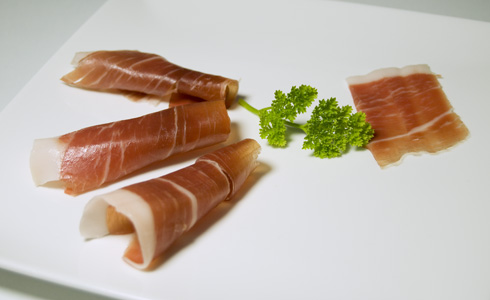|
salting
Cellar aging.
Serrano ham ready to eat.
|
The production of ham has always been the best way to keep meat by means of salting and later drying of ham. The current process of elaboration has been inherited from the traditional method, which started with the sacrifice of pigs in the coldest months of the year , November and December , in order to carry out the salting and post-salting process. The rest of the process was made according to the natural cycle of the seasons. When spring and summer arrived, according to the increase of temperature , the maturation and drying stage took place, so that the ham remained at rest during autumn.
SALTINGOnce pigs are sacrificed, hams arrive into our facilities, where we just select those ones that fulfill the most demanding health and quality criteria. The amount of fat and weight of ham are indispensable factors to select a high-quality row material . Before the elaboration process is initiated, the temperature of each piece is verifield and they classified according to its size. Within a drum they receive a light massage with nitrificant salts, facilitateing the penetration of salt and contributing to the development of the typical color and smell of cured products . Afterwards, the salting is performed, completely covering the pieces with sea salt at a temperature between 0 and 4 ° C , for guaranteeing a correct salting. Salt will favour dehydration and conservation of meat . The time they remain within the salt depends on the weight, fat and features of each ham . when this stage ends, they will be washed or desalted with water to remove the excess of exernal salt. For improving the uniformity of the product cut, it is recommended to ferform in this stage a light pressing or moulding. POST-SALTINGThe aim of the stage of posts-salting is to achieve an homogeneous distribution of the salt inside the ham,at the same time that a slow and gradual removal of superficial wáter is achieved. The external side of ham will be affected by the humidity conditions, thus noticing the growth of fungal flora. Hams will be kept under low temperatures between 0 and 6 ° C, and the relative himidity will be between 70 and 95 %. The length of the post-salting stage is variable according to the size of the piece, the kind of polishing, the fat, etc. , but, at least, it will last 40 days. DRYING – MATURATIONIn this stage, the ham continues with its dehydration process according to the phenomenons of proteolysis and lipolysis, which will condition the smell and taste. The temperatura will be increasing progressively from 10-12 ° C until achieving between 28 -34 º C and relative humidity goes down until values between 60 and 80 % . By increasing the temperatura, the fat covering the muscle tissue is merged and this constitutes one of the most typical features of Spanish ham. REST IN WAREHOUSEHams will rest in natural warehouses as long as it is necessary in order to complete the process . Our ham masters will determine the optimal condition of every piece to be commercialized by verifying that the quality parameters are fulfilled. It is essential to perform an olfactory test , la cala, that consist of introducing a sharp cow bone called cala into three different parts of the ham in order to appreciate its curing condition, smell and salt. |
|||||||||||||




